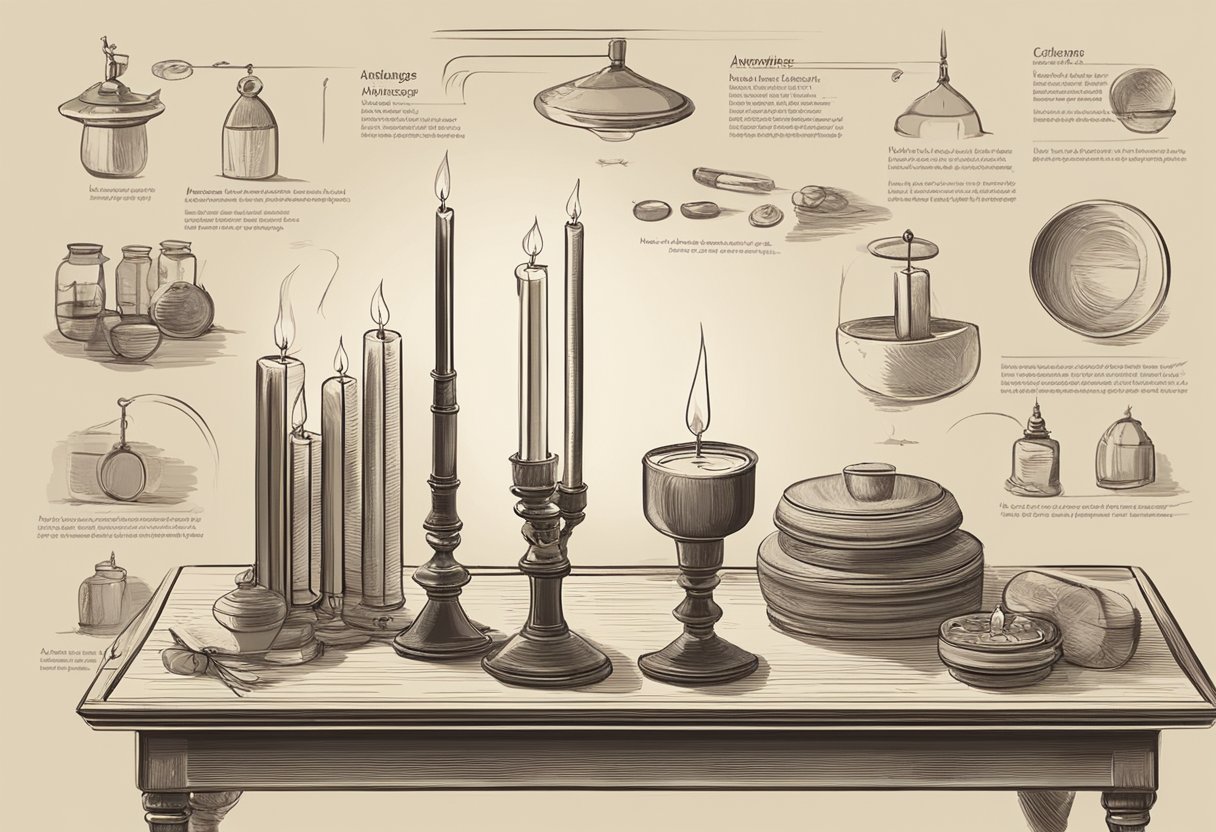What are the Advantages and Disadvantages of Paraffin Candles? A Comprehensive Analysis

Paraffin candles hold a special place in many households due to their affordability and versatility. Made from paraffin wax, these candles are known for their bright and steady flame. One of the key advantages of paraffin candles is their cost-effectiveness, making them a popular choice for everyday use. They are also widely available, allowing consumers to find them in various shapes, sizes, and scents to suit any occasion.
Yet, paraffin wax candles also come with some drawbacks. They are derived from petroleum, which raises concerns about their environmental impact and the potential release of harmful chemicals when burned. Some users may experience headaches or allergies from the fumes emitted by paraffin candles, posing a disadvantage compared to alternative materials like soy or beeswax.
Despite these cons, paraffin candles continue to be a mainstay in many homes. With their long burn time and strong scent throw, they remain a go-to option for those looking to create a cozy and aromatic atmosphere without breaking the bank.
Composition and Properties

Paraffin candles are made from paraffin wax, a byproduct of petroleum refining. They are popular due to their cost-effectiveness, ease of use, and versatile properties such as color and scent retention.
Paraffin Wax Fundamentals
Paraffin wax is derived from petroleum. It is highly refined and purified for candle use. This wax is colorless and soft, making it easy to mold into various shapes. Paraffin wax does not occur naturally and needs chemical processing. One key property is its ability to burn evenly. The wax offers a smooth and consistent burn, ensuring the entire candle melts uniformly. This even burning results in less wasted wax.
Melting Point and Temperature Considerations
Paraffin wax has a low melting point, typically between 120-160°F. This makes it easy to work with, especially for home candle-making. The low melting point also ensures the wax melts quickly and releases fragrance efficiently. However, the lower melting point means these candles can be sensitive to warm environments. High temperatures can cause them to slump or deform. This temperature sensitivity should be considered when storing and displaying paraffin candles.
Color, Scent, and Aesthetic Flexibility
Paraffin wax is highly adaptable in terms of color and scent. It readily absorbs dyes and pigments, allowing for a wide range of vibrant colors. This makes it a favorite among commercial candle makers for producing aesthetically pleasing candles. The wax also holds and releases scents effectively. This property makes paraffin candles capable of offering strong and lasting fragrances. The aesthetic flexibility of paraffin wax is a significant advantage, especially for decorative and scented candles. Its versatility and cost-effectiveness make paraffin a popular choice despite some environmental concerns surrounding petroleum products. By understanding its properties and handling it well, users can fully enjoy the benefits of paraffin candles.
Health and Environmental Concerns
Paraffin candles are popular, but they come with some health and environmental issues. This includes concerns about the toxins they release and their impact on indoor air quality, as well as sustainability challenges since they are derived from non-renewable resources.
Toxicity and Indoor Air Pollution
Paraffin candles, made from petroleum byproducts, release volatile organic compounds (VOCs) when burned. These compounds include harmful substances like benzene and toluene, which can affect indoor air quality. Burning paraffin candles can also release hydrocarbons and other toxins into the air. This may pose health risks, especially for those with respiratory problems or sensitivities. Proper ventilation is important to reduce indoor air pollution. Some people prefer alternative candle types, such as soy or beeswax, which may emit fewer harmful substances.
Sustainability and Source Material
Paraffin wax comes from petroleum, a non-renewable resource. The extraction and refining of petroleum have significant environmental impacts, contributing to pollution and resource depletion. Unlike beeswax or soy, which are renewable and can be produced sustainably, paraffin's production and use raise environmental concerns. For eco-conscious consumers, using candles made from more sustainable materials can reduce their environmental footprint. Soy, stearin, and beeswax candles are good alternatives, offering a more eco-friendly choice. In summary, while paraffin candles are cost-effective, they contribute to indoor air pollution and environmental issues.
Advantages of Paraffin Candles
Paraffin candles are known for their cost-effectiveness, versatility in candle making, and excellent scent throw performance. These qualities make them a popular choice among candle enthusiasts.
Cost-Effectiveness and Availability
Paraffin wax is widely available and relatively inexpensive. This makes paraffin candles affordable for most people. They are derived from crude oil during the refining process, which keeps production costs low. Many consumers appreciate the affordability as it allows them to buy more candles or invest in higher quality scents. This cost-effectiveness makes it easier to experiment with different fragrances and styles without a significant financial commitment. Commercial producers also benefit from the lower cost, making these candles a staple in many households.
Versatility in Candle Making
Paraffin wax offers great versatility in candle making. It can be used for various types of candles, including container candles, pillar candles, and votives. The wax is easy to color and holds fragrances well, making it a favorite among DIY candle makers. Different wax options, such as IGI 4627 and IGI 4630, provide specific benefits like better fragrance load capacity and easier mold release. This versatility allows for more creativity and customization in candle crafting, whether for personal use or as gifts.
Scent Throw and Performance
One of the standout features of paraffin candles is their excellent scent throw. They can hold a higher percentage of fragrance oil compared to other waxes, making the scent stronger and more noticeable. This is particularly beneficial for those who enjoy a highly fragrant environment. Due to the refining process, paraffin wax burns cleanly and efficiently, resulting in a longer-lasting candle. Strong scent throw and dependable performance make paraffin candles a reliable choice for those seeking a pleasant and enduring scented experience.
Disadvantages of Paraffin Candles

Paraffin candles have several drawbacks, such as potential health concerns and environmental impacts. They can also affect the quality of indoor air and illumination.
Health Risks and Environmental Drawbacks
Paraffin candles can release toxins when burned. They often produce smoke containing substances like toluene and benzene, which are harmful to breathe in. This can lead to indoor air pollution and require proper ventilation to mitigate negative effects. Some people might experience irritation in their respiratory system, particularly those with asthma or allergies.
In addition to health concerns, paraffin production involves resources that may harm the environment. The extraction and refining processes can cause environmental impact through the release of pollutants. Also, paraffin is a petroleum byproduct, meaning its use is tied to fossil fuels, which have broader environmental ramifications.
Quality of Illumination
Paraffin candles are known for producing a decent amount of light but often generate smoke that can affect air clarity. The quality of illumination from paraffin candles can be inconsistent. They might flicker more than other types of candles, disrupting the experience. Additionally, paraffin candles do not release negative ions as some other types of candles do, which can help improve air quality and mood. The constant smoke and soot can leave residues on walls and furniture, reducing the overall aesthetic appeal and requiring extra cleaning effort.
Alternatives to Paraffin Wax

Paraffin wax is common, but there are natural alternatives that offer benefits like longer burn times and being eco-friendly. Let's explore soy and beeswax candles and other natural wax options.
Soy and Beeswax Candles
Soy wax is made from soybeans, making it a vegan-friendly choice. It burns cleaner than paraffin, releasing less soot, which is better for indoor air quality. Soy wax candles also burn longer because the wax is dense and melts slower. They can be infused with essential oils for added fragrance benefits. However, they can be more expensive.
Beeswax candles are another natural alternative. They provide a clean, long-lasting burn and may even purify the air. Unlike soy, beeswax is not vegan, but it’s a highly renewable resource. Beeswax candles also tend to have a natural honey scent, which can add to the ambiance of a room.
Other Natural Wax Options
- Coconut wax is another eco-friendly option. It burns clean, has a slow melt rate, and mixes well with essential oils for strong fragrance retention. Coconut wax candles are often more expensive but offer a high-quality burn.
- Palm wax is durable and can be sourced sustainably, though sustainability depends on farming practices. It creates a crystalline pattern when it solidifies, adding a unique aesthetic.
There are also unique blends of these natural waxes that combine the benefits of each. For example, soy-coconut blends offer a balance of long burn times and excellent fragrance throw.
Lists can help organize these alternatives neatly:
- Soy Wax: vegan, longer burn time, cleaner burn, costlier
- Beeswax: long-lasting, natural scent, renewability, not vegan
- Coconut Wax: eco-friendly, slow melt, high cost
- Palm Wax: sustainability varies, unique look
This detailed look at natural waxes forms a strong basis for understanding their benefits and limitations compared to paraffin.
Practical Tips for Paraffin Candle Making
Making paraffin candles at home can be rewarding and enjoyable. By choosing the right materials and following a precise process, you can create high-quality candles.
Selecting the Right Materials
The first step in making paraffin candles is gathering the essential materials. Choose paraffin wax specifically meant for candles. Look for types like IGI 4627 or IGI 4630, which work well for container candles. Select a wick that suits the candle's size. Pre-waxed wicks often lead to a more stable flame. Make sure to have a double boiler or melting pot for safely melting the wax. A thermometer is crucial to monitor the temperature, as adding fragrance oils at the correct temperature ensures better scent throw. Consider using molds for pillar candles or containers for container candles. Opt for high-quality fragrance oils and candle dyes to customize your candles. Additives can also be included to improve the burn performance and appearance of the candles.
The Candle-Making Process
Begin by setting up your workspace, making sure it is free from drafts. Melt the paraffin wax in a double boiler, keeping a close watch on the temperature. Once melted, add fragrance oils when the temperature is around 185°F to maximize aroma absorption. Prepare your molds or containers by securing the wick in the center. You can use a wick holder to keep it straight. Pour the melted wax into the mold or container slowly to avoid air bubbles. Allow the candle to cool and harden completely. Trim the wick to about ¼ inch before lighting it. This will help the candle burn more smoothly and evenly. With these tips, you can create beautiful and personalized paraffin candles right at home.
Candle Care and Maintenance
Caring for paraffin candles involves practices to extend their burn time and ensuring safe handling. Using these tips ensures that your candles provide satisfactory illumination and decor while maintaining safety.
Ensuring a Longer Burn Time
Ensuring a longer burn time for paraffin candles requires regular maintenance. Trim the wick to about 1/4 inch before each use to minimize soot and extend burn time. Avoid drafts as drafts can cause uneven burning and shorter life. If the candle forms a tunnel (burning down the center and leaving wax on the sides), wrap the candle's top with foil, leaving an opening to burn. This helps melt the excess wax evenly. Store candles in a cool, dry place away from direct sunlight. Heat or light can warp candles and affect their burn quality. Use a snuffer to extinguish the flame instead of blowing it out to prevent wax splatter.
Safety and Handling Practices
When using paraffin candles, prioritize safety. Place candles on a stable, heat-resistant surface to avoid accidental tipping and burns. Keep candles away from flammable items like curtains, books, and paper. Never leave a burning candle unattended. Ensure that children and pets cannot reach the flame. Always use a candle holder or container to collect melted wax and prevent spills. When handling melted wax, avoid contact with skin to prevent burns. If wax spills, allow it to harden before scraping to avoid smearing. Never move a burning candle to prevent accidents and burns. Using these practices can make your candle experience safer and more enjoyable.
Additional Uses of Paraffin Wax
Paraffin wax is used in various ways beyond making candles. It is valuable for cosmetic and therapeutic benefits, as well as industrial and domestic applications.
Cosmetic and Therapeutic Applications
Paraffin wax is popular in cosmetic treatments, especially for hands and feet. Salons often use it to soften skin and cuticles. The wax is a natural emollient, making the skin smooth and supple. A paraffin treatment can also relieve sore joints and muscles. For pain relief, it helps people with arthritis by increasing blood flow and relaxing muscles. DIY enthusiasts can use it for homemade treatments at home.
Industrial and Domestic Utility
In industrial settings, paraffin wax is used for electrical insulation to protect wires. It is also a key ingredient in making crayons; its flammability makes it useful for firelogs. Domestically, it coats food items to keep them fresh. People often use it in DIY projects, like homemade candles, because it is versatile and easy to work with.




